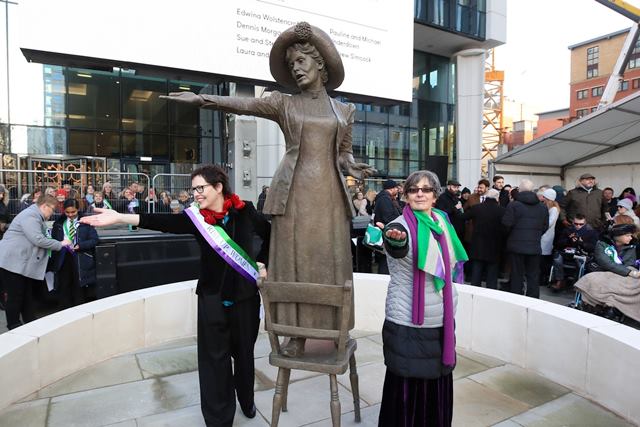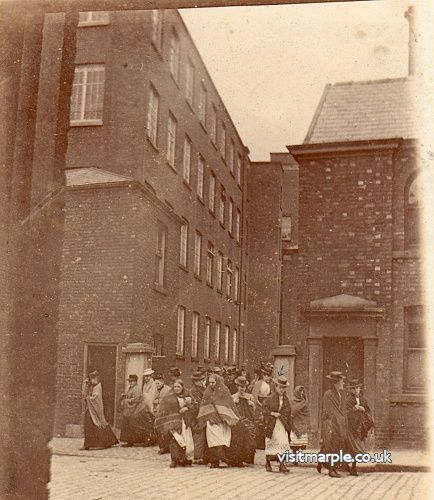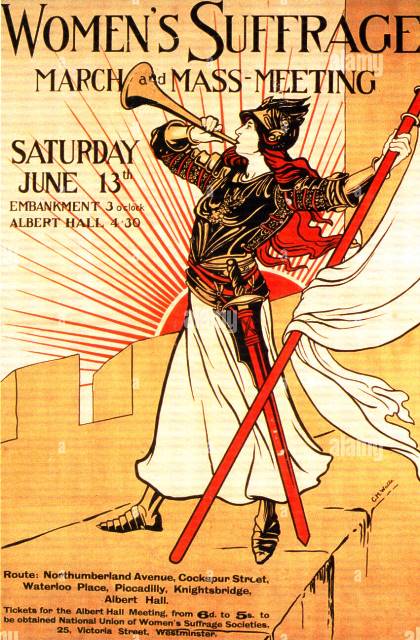 Helen Pankhurst, the great granddaughter of Emmeline Pankhurst, stands next to a statue of Emmeline, by sculptor Hazel Reeves following its unveiling in St Peter's Square in Manchester on 10th December 2018. The 10th December election of 1918 saw 8.5 million women eligible to vote and 17 female candidates stand for election, although only one was elected- and she never went to Parliament. link
Helen Pankhurst, the great granddaughter of Emmeline Pankhurst, stands next to a statue of Emmeline, by sculptor Hazel Reeves following its unveiling in St Peter's Square in Manchester on 10th December 2018. The 10th December election of 1918 saw 8.5 million women eligible to vote and 17 female candidates stand for election, although only one was elected- and she never went to Parliament. link
{click on the image to see a close-up of the sculpture}
The November talk was the story of a statue. Not just any statue but the statue of Emmeline Pankhurst, the iconic figure symbolising the fight for universal suffrage. And how fitting that she should be commemorated in Manchester, the city of her birth. Andrew Simcock took us through the various stages from conception to completion after introducing himself as a Manchester councillor for Didsbury East.
- The initial idea - (By a woman, of course. It would never have occurred to a man)
- Council agreement. - (Provided it didn’t cost the ratepayers one penny)
- Preparing a long list of candidates - (Twenty women with a Manchester connection)
- Raising funds (Including the Lands End - John O’Groats bike ride, average 48 miles per day.)
- Choosing the short list sculptors (Four men, two women)
- Voting for the subject (Emmeline Pankhurst by a landslide - 56% of the vote)
- Voting for the artist (Appropriately a woman, Hazel Reeves)
- Installation and unveiling (14th December 2018.)
[click on the poster to see a second one]
Manchester was very proud of itself commemorating a pioneering woman exactly 100 years to the day after the first election when women were allowed to vote. However, as Andrew pointed out, of the eighteen statues in the city centre, only one was a woman - and that was Queen Victoria. Indeed two of the surrounding towns, Rochdale and Oldham, had outdone Manchester by commemorating notable women. Rochdale was the first borough in Greater Manchester to unveil the statue of a woman, in this case Gracie Fields, in 2016. Oldham followed with a statue of the suffragette, Annie Kenny, which was unveiled on the same day as Emmeline Pankhurst but slightly earlier.
It seems wrong that only one woman of the twenty that were put forward has been chosen. Andrew listed them all briefly but they deserve more recognition. Some are well-known but others, equally deserving, are little more than names. How many of these do you know?
- Margaret Ashton 1856 - 1937
A suffragist and local councillor championing local health issues.
- Lydia Becker 1827 - 1890
A Manchester born amateur scientist who took up the suffragist cause at an early stage and founded the Women’s Suffrage Journal.
- Louise Da-Cocodia 1934 - 2008
A Jamaican nurse who made Manchester her home and campaigned vigorously for race equality. A magistrate and appointed Deputy Lieutenant of Manchester.
- Margaret Downes ???? - 1819
One of the four women who died at the Peterloo meeting. A further 168 women were injured.
- 1Elizabeth Gaskell 1810 - 1865
Brought up in Knutsford, Elizabeth married the minister of the Cross Street Unitarian Chapel, a key meeting place for social reformers. She played a key role in promoting social reform with her novels.
- Annie Horniman 1860 - 1937
A theatrical entrepreneur who founded the first regional repertory company in Britain at the Gaiety Theatre. A well known figure in the artistic life of the city.
- 2Sunny Lowry 1911 - 2008
Manchester born and bred. A pioneering long distance swimmer. One of the first women to swim the English Channel.
- Hannah Mitchell 1872 - 1956
A working class worker for the WSPU who then entered politics and became a Manchester City councillor.
- Kathleen Ollerenshaw 1912 - 2014
A mathematician based in Manchester who became a councillor and then Lord Mayor of Manchester. A freeman of the city and adviser on education to Margaret Thatcher.
- Christabel Pankhurst 1880 - 1958
Eldest daughter of Emmeline and organised the activities of the WSPU, later from exile in France.
- Emmeline Pankhurst 1858 - 1928
Born in Manchester and co-founder of WSPU (suffragettes.) Was the leader and initiated many of the civil disobedience demonstrations and direct action. One of the first suffragettes to go to prison (for spitting at a policeman.)
- Sylvia Pankhurst 1882 - 1960
Younger daughter of Emmeline and initially member of WSPU. Fell out with her family as was committed socialist.
- 3Elizabeth Raffald 1733 - 1781 Entrepreneur in Manchester publishing both directories and a very popular cook book. Established an employment office for domestic servants.
- Esther Roper 1868 - 1938
One of first female students at Owens College (Manchester University). Became active suffrage worker and lived openly with Eva Gore-Booth.
- Enriqueta Rylands 1843 - 1908
Widow of John Rylands who built up the largest textile manufacturing concern in UK. She inherited £2.5 million (£350 million today) and built John Rylands Library in his memory and bought several collections of books. The first woman to be made a Freeman of Manchester.
- Olive Shapley 1910 - 1999
Innovative broadcaster, television producer and educationist.
- 4Shena Simon 1883 - 1972
Educated at Cambridge and LSE but became a ‘steamboat lady’ in order to get a degree. Married Ernest Simon (Simon Engineering). Active in local government and gave Wythenshawe Park to Manchester.
- Marie Stopes 1880 - 1958
Became first female academic at Manchester University as a paleobotany (sub set of geology). Wrote book on birth control and achieved national prominence. Established birth control clinics against widespread opposition.
- Ellen Wilkinson 1891 - 1947
Working class graduate joined National Union of Women’s Suffrage Societies. Became trade unionist. Became MP for Middlesborough then Jarrow and was leading light in Jarrow March. Minister of Education in 1945-47.
- Emily Williamson 1855 - 1936
Philanthropist and co-founder of Royal Society for Protection of Birds.
Notes:
1 The Society visited Gaskell House, along with Victoria Baths, read here
2 In March '19 Suze Appleton delivered a talk the Society on Elizabeth Raffald, click link
3 Shena Simon, a 'steamboat lady' links...
Link 1: In 1904, the ‘Steamboat Ladies’ Kicked Off a Trinity Equality Battle. It’s Still Going
Link 2 : 45 minute Radio Documentary
 Mill Girls Leaving Hollins Mill
Mill Girls Leaving Hollins Mill
Andrew wound up his talk by describing his current venture,being involved with others, in an effort to erect a statue for Emily Williamson, the co-founder of the RSPB. However, Hilary Atkinson, in thanking him for his talk, conjectured on the erection of a statue closer to our hearts - of the mill girls leaving Hollins Mill, based on the iconic photograph above, drawn from our archive. However, if a statue of one woman costs £165,000 what would a statue of a group of women cost? Would the sculptor give a discount for quantity?
Neil Mullineux - November 2021
Further reading etc:
The WoManchester Statue Campaign
The unveiling of the Pankhurst Statue Ceremony video here
Manchester Community Choir: Nana was a Suffragette YouTube Video
And the launch video for the Emily Williamson statue campaign is here:
And a lot more on the campaign here: www.emilywilliamsonstatue.com
Women of Significane
Suffragettes


































